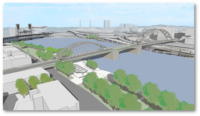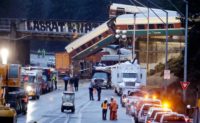
The nation's longest non-vehicular multi-modal bridge, set to open on Sept. 12 across Portland, Ore.'s Willamette River, elevated risk management to a priority early on to help crews overcome unexpected site conditions.
Getting to the September opening started long before the 2011 construction kickoff. Owner TriMet, the region's transit provider, took the concept of risk-sharing, as opposed to risk-shifting, to a higher level, starting with a request for industry comment. That triggered a dialogue on risks, costs and risk control well before the request-for-qualifications stage. Dan Blocher, TriMet's executive director of capital projects, says he believes it was the first time a risk table was put in at the procurement level.
"It was very unique and very forethinking," says Lee Zink, Kiewit Infrastructure area manager in charge of the Tilikum Crossing project. "At first, it was so out of the ordinary, we didn't know what to make of it."
The 1,720-ft-long, 75.5-ft-wide cable-stayed bridge, designed by T.Y. Lin International, will accommodate light rail, streetcar, bus, bicycle and pedestrian crossings-all for a budget of $135 million. The bridge is supported by two 180-ft-tall towers. Blocher says the committee choosing the design was adamant about having shorter H-shaped towers, so the contractor had to devise a system that runs 3.5 miles of cables continuously through a pylon saddle, with tight tolerances.
Six contractors pursuing the project met individually with TriMet to discuss the risk matrix, which TriMet then adjusted based on the comments. The matrix included everything from dollar values to which party would perform the extra work.
Zink was still wary of the increased detail heading into the project, he says. But early on, risks materialized when foundation work on a bridge support uncovered site conditions different from what was expected. Zink says using the matrix out of the gate allowed for a fair implementation.
Low water in the Willamette River delayed the start due to environmental regulations. Once underway, soil remediation requirements on one shore forced the contractor to flip the script and start on the other side.
According to Blocher, the project team always planned to start on the west side, but the contractor was delayed 13 calendar days due to the adjacent and concurrent in-water soil remediation by a third party.
The subsurface was more stout than had been anticipated, which became another challenge. It added time-32 days-and cost to drill through the Troutdale formation, which comprises fluvial sediments of mudstone, sandstone and conglomerate.
The problems could have sent the owner and contractor into documenting, finger-pointing and potentially more delay. With the matrix, both parties went straight to the risk table, which not only assigned the risk immediately but allowed the owner to quickly tap needed funds to handle change orders.






